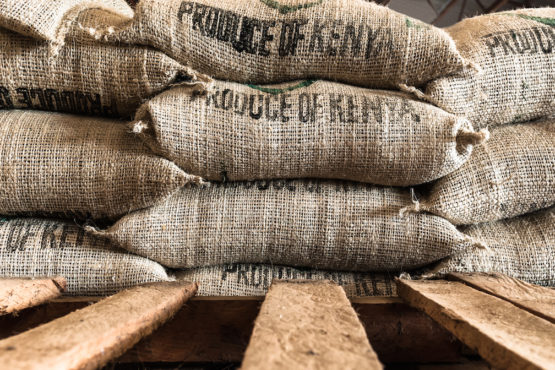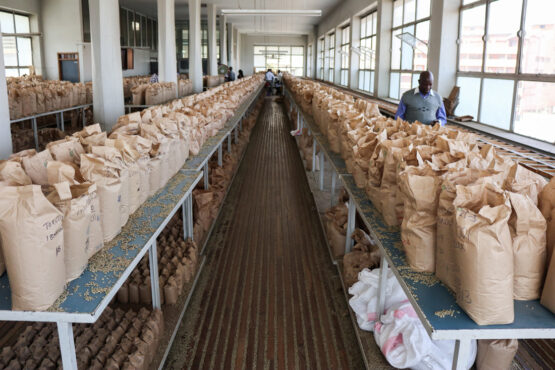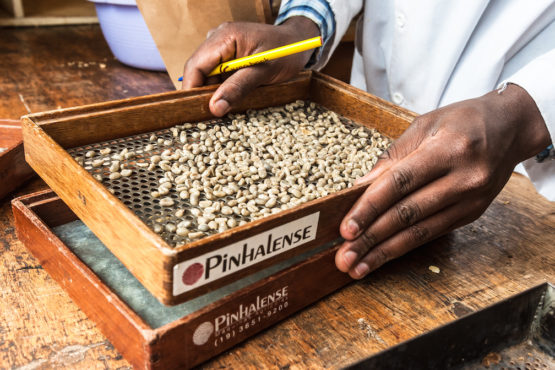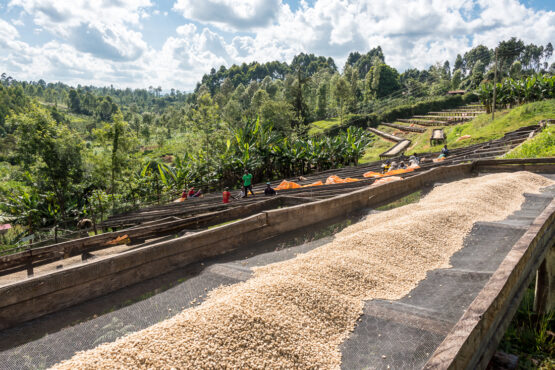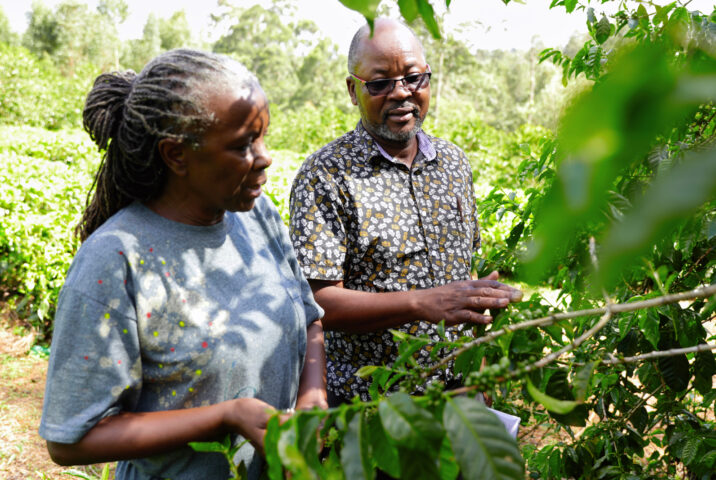Kenya
Kenya produces some of the most exquisite coffee in the world. The best Kenyan coffees have a sparkling acidity, juicy mouthfeel, incredible floral aromatics, complex ripe fruit flavours and intense sweetness.
Most of the coffee in Kenya is grown in the central highlands to the north and northeast of Nairobi, on high plateaus situated in the foothills of Mount Kenya and the Aberdare Mountains. Larger estates are concentrated in Kiambu county’s growing region (which includes the towns of Thika, Ruiru and Limuru), which is located conveniently close to Nairobi and is also home to many coffee mills and warehouses. Smallholder farmers are found further afield in Nyeri, Kirinyaga, Embu, Murang’a and Meru counties. Coffee is also grown in the western parts of Kenya, where the farms have been more recently established. Key regions here include Nakuru and Baringo (close to central Kenya), Kisii (in the southwest) and Trans-Nzoia, Keiyo and Marakwet (located further to the west, nearby Uganda).
Central Kenyan coffees are known for their high-quality and complexity, thanks to the region’s exceptional natural conditions for coffee production, and a high concentration of established and organised cooperatives that manage well run wet mills (or factories, as they are known in Kenya). The west has also emerged as an exciting new region with great potential. While the cooperatives here are more recently established than in the central counties, the climate and elevation have great potential for producing exceptional coffee and many exporters are investing in gaining access to coffees from this region.
Coffee production in Kenya accounts for around 10% of the country’s exports, or some 465,000 tonnes of coffee annually. Almost all exportable coffee is processed using the washed method and dried on raised African beds. There are two major harvest cycles in Kenya: the fly crop (mitica), which runs from February to July, and the main crop, which runs from September to December.
History of Coffee in Kenya
Coffee was introduced to Kenya in the late 1800s by French and Scottish missionaries but wasn’t commercially produced until the start of the 20th century, following Britain’s colonisation of the country. By 1920, coffee had become Kenya’s largest export product. In 1933, the Kenyan Coffee Board was established, and the country’s auction system was set up the following year. Protocols were soon established to grade coffee and improve quality.
For the first half of the 20th century, coffee was produced on large British-owned estates under colonial rule. It was not until the Mau Mau uprising in 1954 – which ultimately led to land reforms and the country’s independence in 1963 – that African Kenyans were entitled to own land or plant coffee, and production began to be transferred from the British to Kenyans. Many smallholder farms — particularly in the central region — were established during the 1950s and 60s, along with cooperatives and wet mills to process their coffees.
By the late 1970s, the volumes produced by smallholder estates had surpassed that of the larger estates. Today, smallholders represent about 55% of production. It is estimated that there are around 700,000 small growers in Kenya. Most are members of one of several hundred cooperatives that own and operate centralised wet mills, where farmers deliver fresh cherry during the harvest. The remainder of Kenyan coffee is grown on medium or large estates, most of which have their own wet mill, and sometimes dry mill.
The Kenyan Auction System
The Kenyan auction system was established in 1933 to trade milled green coffee ahead of export. Today, over 95% of Kenyan coffee is still sold via this weekly, government run auction. Way ahead of its time, this transparent and centralised system has established a pricing hierarchy based on quality, with higher quality lots fetching higher prices. This model is widely considered to be the most transparent and effective price-discovery and distribution mechanism for fine green coffees anywhere in the world and even inspired the Cup of Excellence auction model. Since 2021, weekly auctions have been held online, however, sampling and business meetings still take place at the Nairobi Coffee Exchange in downtown Nairobi.
For many years, the auction platform was the only way that coffee could be sold and bought in Kenya. In 2006, new legislation was introduced to allow coffee to be purchased directly from a cooperative or estate, through a licensed marketing agent employed by the grower. In 2023, the Kenyan government introduced a series of reforms to the industry, which saw the marketing agent’s function replaced by a broker or agent, who facilitate sales through the auction or directly to the buyer, respectively.
Read more about Kenya’s recent reforms here.
The Chain of Custody in Kenya
The chain of custody in Kenya is regulated to protect the coffee grower, in that the coffee belongs to the farmer or cooperative until it has been sold to the final buyer, either through the auction system or directly. A Kenyan coffee farmer will either deliver their coffee cherry to a cooperative owned factory (or washing station) where it is processed before being delivered to the dry mill or will process the coffee on their own farm and deliver dried parchment it to the mill directly.
Unlike other producing origins, growers in Kenya are only permitted to sell milled, green coffee. At the milling stage, the coffee comes under the custody of a broker or agent.
Brokers are employed by the grower to represent them at the auction, where their coffees are bid on and bought by a trader. The grower may enter price negotiation following the auction, liaised through the broker. In this model, the farmer pays a 2% commission to the broker. The trader sells the coffee on to the final buyer (such as MCM), who pays an FOB price once the coffee has been prepared for export and transported to the port.
Coffees sold directly are bought by the buyer after the coffee has been milled, in a transaction that is facilitated by a licensed agent. The agent is responsible for guiding the grower through the milling process (in some cases, they may recommend a particular facility, or advocate on behalf of the farmer to have their coffee milled as a separate lot), gathering samples for the buyer to cup, liaising in price negotiations and ensuring all documentation is in order. They also assist the buyer in contracting additional services to prepare the coffee for export, such as warehousing, packaging, lot consolidation and transport to port. In this model, the buyer pays the agent a 2% commission.
Kenyan law prohibits that a single company can operate as the grower, miller, marketing agent and trader. Since 2023, agents and brokers cannot be affiliated with any mill and trader.
Our Supply Partners in Kenya
Since we first bought coffee from Kenya in 2017, our line-up has celebrated small estate holders who process and market their coffees independently of the cooperative system. In Kenya (as with all the origins we source from), our goal is to invest in direct relationships and work towards a long-term committed partnership with small producers and cooperatives that benefit both parties.
To achieve this, we work closely with Wycliffe Murwayi who is a licensed agent and facilitates direct sales between MCM and small holder growers and quality focused cooperatives. Wycliffe is a long-time friend to MCM who has recently established an independent agency, Agriwyse. He has an extraordinary knowledge of Kenya’s coffee industry and the people that work within it, and his work over the past three decades has undoubtedly contributed to higher quality and volumes across the sector. As an expert agronomist, Wycliffe has played a pivotal role in providing advice and resources to farmers to improve agricultural and processing practices and establish healthy and resilient farms.
Wycliffe is instrumental in connecting MCM to smallholder farmers and forward-thinking cooperatives, and in communicating our needs to these players. Through his network, we have cupped and committed to buying lots from several small estate holders in Kenya’s central highlands. Read more about Wycliffe, in his own words, here.
In addition to buying from small, independent estates, we also buy directly from forward thinking and quality focused cooperatives. These cooperatives are farmer owned and represent smaller farmers who typically own less than 5 acres of land. We are able to secure larger lines from these cooperatives, and find the quality to be very high and consistent, as the factories are able to invest significant resources into ensuring the coffee is processed with a high level of care and attention.
Grading
Grades within the Kenya system are simply a measure of bean size, not of defect tolerance. Typically, the best lots are either AA (screen 17/18), AB (screen 15/16), or PB (grade for peaberries, where a single bean has grown inside the coffee cherry instead of two).
AA grades are usually considered superior and command the highest prices, but sometimes AB lots can be more complex and of a higher quality than AA lots. We therefore always trust the cupping table when selecting coffees for purchase and ensure this is what guides our purchasing decisions.
Varieties
In the specialty coffee world, Kenya is famous for two unique varieties: SL-28 and SL-34. Both have Bourbon and Moka heritage and are named after the laboratory that promoted their wider distribution in Kenya during the early 20th century – Scott Laboratories (now the National Agricultural Laboratories of Kenya).
These varieties are prized for their exceptional flavour, distinctive body, and winey blackcurrant notes. Other varieties, such as Batian and Ruiru 11 (both of which are known for their resistance to Coffee Berry Disease and Leaf Rust) are becoming increasingly common as well.
Processing
Around 99% of exportable coffee in Kenya is processed using the washed processing method. In response to market trends, some growers have recently been experimenting with fermentation techniques or natural processing, however this is not a widespread practice.
Coffee cherries are carefully hand-picked and delivered, either directly to the wet mill or to a collection centre. They are transferred to pre-sorting mats or tables, where any unripe or damaged cherries are removed. The coffee is then weighed and processed using the washed processing method.
The coffee cherries are placed in a tank of water and sorted using a floating technique to remove immature beans or non-coffee materials. The coffee is then pulped using a disc pulper to remove the skin and fruit from the inner parchment layer that protects the green coffee bean. After being pulped, the coffee is sorted by weight using water, with the highest quality and densest beans being separated out from the lighter, lower quality beans.
After pulping, the coffee is dry fermented overnight to break down the sugars, before it is cleaned using water, sorted once more via water channels (the heavier coffee, which sinks, is considered the higher quality, sweeter coffee). At some processing sites, the coffee soaked for a further 24 hours in clean water. This process strengthens the proteins and amino acids in the bean which, in turn, heightens the complexity of the acidity and the clarity in the cup.
After washing, the coffee is spread out on raised drying tables (also known as African beds) where it is turned constantly to ensure the coffee dries evenly and hand sorted to remove any defective seeds. Time on the drying tables depends on climate, ambient temperature and volumes under processing. It can take anywhere from 1 to 3 weeks to get to the target moisture level of 11-12%.

